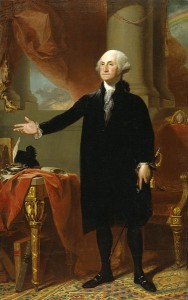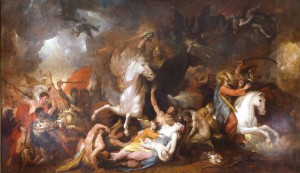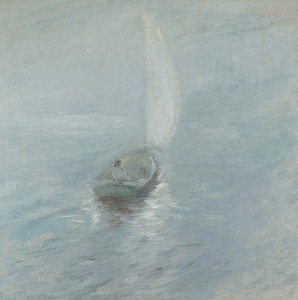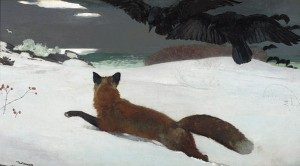Jayson Musson’s alter ego Hennessy Youngman dubs himself “The Pharaoh Hennessy,” “The Rowhouse Raconteur,” and now with his cell phone audio tour of PAFA’s collections, “Mr. Museum.” In The Grand Manner, Youngman shares his own perspective on twenty-two works of early American art. In a collection that prides itself on its number of masterpieces, Youngman both literally and figuratively becomes the voice inside your head, validating the opinion of the non-expert with his unpretentious and witty commentary.

Hennessy admits to having trouble telling white people apart. In his comparison of paintings of King George III and George Washington it is only through their differences in clothing that Youngman is able to distinguish the two men. The paintings hang side by side to contrast the King’s royal excess with Washington’s plain dress that embodies democracy. However, Youngman thinks King George III makes George Washington look like “an Amish carpenter,” and if King George III had remained in power, “America … could have been somethin’.”

With its “high drama and gesturin’,” Youngman imagines that for “people of olden times,” viewing Benjamin West’s painting “Christ Rejected” must have been like his experience of seeing Gollum in “The Lord of the Rings” for the first time. However, he admits that to contemporary viewers like himself, the painting seems unrealistic and “reeks of a European mannerism that always seemed unnatural to [him].” Youngman also finds West’s other large work, “Death on a Pale Horse,” to be excessive with its dark, ominous clouds, naked, wailing figures, and dead doves.

In addition to his audio tour, Youngman also makes his presence visible by including video works alongside the collection. His “Shrine to Bas Jan Ader” pairs the conceptual artist’s works “I’m Too Sad to Tell You” and “Broken Fall” with “Sailing in the Mist.” Bas Jan Ader disappeared during a sailing trip and the painting without a clear horizon is a fitting image. Another painting of the sea, Alexander Harrison’s “The Wave,” is paired with Youngman’s video, “Bodhi Swata,” a looping fragment of the surfing movie “Point Break.” The seascapes become backdrops for Youngman and their own artistic significance becomes secondary.

In contrast to Youngman, the exhibition also features another persona, Nathaniel Snerpus, an art writer who divulges information about his personal life. Snerpus, tells visitors to disregard Youngman’s commentary and instead to look for his writing throughout The Grand Manner. Despite Snerpus’ claims of being an authority, his writings become tangents about his recent divorce. In Winslow Homer’s “Fox Hunt,” Snerpus sees himself as the fox being victimized by the attacking crows. In another text panel, Snerpus quotes an art reviewer from 1898 who saw one of William Merritt Chase’s works, “Mother and Child” (not in the collection), as an embodiment of fearlessness. Whether the portrait embodies fearlessness or not is subjective and no more valid than a conclusion reached by a non-expert.
With the two personas — Snerpus and Youngman — Musson provides an alternative perspective that conflicts with the museum’s traditional, widely-accepted interpretation. Musson’s decision to include text from the so-called authority Snerpus also underscores the fact that the exhibition’s wall text is a constructed interpretation.
Hennessy Youngman & Nathaniel Snerpus Present: The Grand Manner is on view at the Pennsylvania Academy of Fine Arts’ Historic Landmark Building until February 5, 2012. The cell phone audio tour can also be downloaded on to an iPod from Hennessy Youngman’s website.









